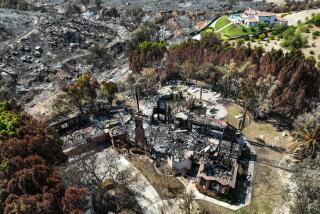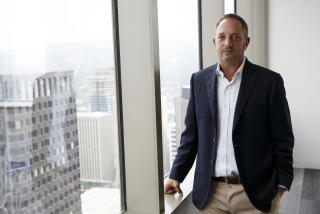Tower May Have Escaped Serious Structural Damage
Owners of the fire-scarred First Interstate Bank building said Thursday that it appeared the downtown Los Angeles skyscraper escaped serious structural damage but announced that it could take up to two months before bank employees and other tenants on the lower 21 floors are allowed to return.
“An awful lot of the infrastructure has to be put back in place,” said Harold J. Meyerman, president of First Interstate Bank Ltd., half-owners of the structure, after inspecting the 62-story high-rise.
“We have five floors that sustained major fire damage, another five that have significant water damage and then at least five that have significant smoke damage as well,” he continued.
The blaze started on the 12th floor. Smoke damage began at the 17th floor and billowed up “quite a way,” Meyerman observed, while water used to fight the savage blaze deluged the 11th floor just beneath where the flames erupted and then collected in the basement.
“We just know we do not expect to reoccupy the building below the 21st floor for 30 to 60 days,” Meyerman said. “Above that (floor), about two weeks.”
Twisted metal that could be seen from the street actually was aluminum alloy supporting windows that had exploded in the intense heat.
“The stuff that looks bad is clearly not structural,” Meyerman explained. “The structural pieces appear to be very much intact. If you look at the insulation on the major beams--about 10 huge beams--most of the insulation is still very much on there.
“But is that the case everywhere?” he added. “I don’t know. It’s something our building inspectors will have to look at.”
While the bottom third of the building will require extensive repairs, from electrical rewiring to hooking up water systems, Meyerman said tenants above the 21st floor might fare better.
“The elevators are working,” he said. “I’m no engineer but I assume if we had structural problems, the first place you’d have seen them would be in the elevator shafts.”
Tenants will not be allowed to get their office files or equipment without a security escort.
“People are going to be able to remove them, but organized with our building security people,” Meyerman said. “It’s not going to be open access. My guess is we can begin opening the building selectively with security people sometime next week.”
First Interstate occupies 63% of the building, while the rest is filled with other tenants, including law firms, foreign banks and other businesses.
The sudden displacement of thousands of workers could have a dramatic impact on office real estate in the financial district, experts said.
“Every real estate broker active in the downtown market is very busy today,” said John McAniff of Cushman Realty Corp., who said there is ample office space available, even to handle the 1 million square feet now temporarily gone because of the fire.
“I don’t know if they can keep their tenants,” said Christopher C. Martin, managing partner with the architectural firm of Albert C. Martin & Associates. “If I had space there, I would be frantic to get my materials out of that building, set up temporary office space and prepare to go to a long-term lease.”
Martin, whose firm has helped build 50% of the major high-rises downtown, estimated that “if they worked around the clock they could get it done in three months.” He said “major life safety things need to be done” such as repairing stairs, elevators, escape routes, and restoring power and water supplies to the building.
One realtor who asked not to be named said that if the interior walls of damaged offices are insulated with asbestos, that could add $20 a square foot to the cleanup costs, an enormously expensive and environmentally sensitive process.
As for the building itself, Los Angeles city inspectors said it appeared from preliminary walk-throughs that the structure was safe and there was no indication the building was seismically unsound as a result of the fire.
The high-rise, designed by the architectural firm Charles Luckman & Associates, opened in October of 1973. Fire sprinklers were not required for Los Angeles high-rises until the following year. First Interstate Bank moved into the high-rise in 1974, when it was called the United California Bank tower.
Los Angeles City Fire Chief Donald O. Manning, meanwhile, said a fire-retardant substance used to coat the building’s steel beams had been burned away on at least one horizontal beam.
“For it to burn through that (retardant) would indicate the ferocity of the fire,” said South Pasadena architect Jasper Hawkins. “If it did, it was one hell of a fire.”
Hawkins, who served on a blue-ribbon commission that investigated the 1980 MGM Grand Hotel fire in Las Vegas, said that he could not visualize a situation where only having one horizontal beam fail would cause the whole building to be declared structurally unsafe.
“It could be replaced,” he said.
Times staff writer John Dreyfuss contributed to this article.
More to Read
Inside the business of entertainment
The Wide Shot brings you news, analysis and insights on everything from streaming wars to production — and what it all means for the future.
You may occasionally receive promotional content from the Los Angeles Times.






